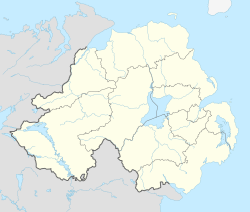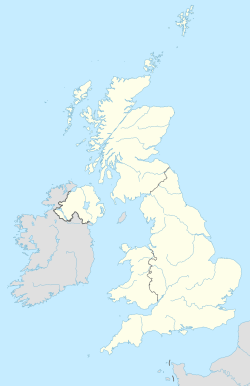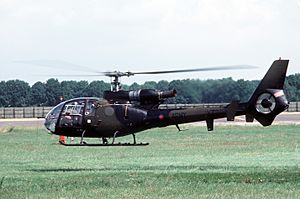JHC FS Aldergrove facts for kids
Quick facts for kids JHC FS Aldergrove |
|||||||||
|---|---|---|---|---|---|---|---|---|---|
| Aldergrove, County Antrim in Northern Ireland | |||||||||
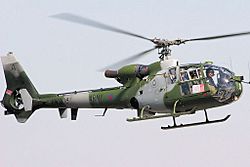
Westland Gazelle AH1 of the type based at Aldergrove.
|
|||||||||
|
Location within Northern Ireland
|
|||||||||
| Coordinates | 54°38′58″N 006°13′31″W / 54.64944°N 6.22528°W | ||||||||
| Type | Joint flying station | ||||||||
| Code | JV | ||||||||
| Area | 96 hectares (240 acres) | ||||||||
| Site information | |||||||||
| Owner | Ministry of Defence | ||||||||
| Operator | British Army | ||||||||
| Controlled by | Joint Helicopter Command | ||||||||
| Condition | Operational | ||||||||
| Site history | |||||||||
| Built | 1918 | ||||||||
| In use |
|
||||||||
| Battles/wars |
|
||||||||
| Airfield information | |||||||||
| Identifiers | IATA: BFS, ICAO: EGAA, WMO: 03917 | ||||||||
| Elevation | 69 metres (226 ft) AMSL | ||||||||
|
|||||||||
Joint Helicopter Command Flying Station Aldergrove, or JHC FS Aldergrove, is a military base in Northern Ireland. It is about 4.4 miles (7.1 km) south of Antrim and 18 miles (29 km) northwest of Belfast. The base is right next to Belfast International Airport. Sometimes, people just call it Aldergrove, after a small village nearby. The military aircraft use the same runways as the airport but have their own separate buildings and helipads.
This place used to be called RAF Aldergrove. It was a base for the Royal Air Force (RAF) from 1918 until 2009.
Contents
History of Aldergrove
Early Years (1918-1939)
RAF Aldergrove first opened its doors in 1918. However, it only became a full RAF station in 1925. During these early years, different RAF squadrons were based here. They flew various types of aircraft, including older biplanes and early bombers. For example, No. 502 Squadron RAF was formed here in 1925.
World War II (1939-1945)
Aldergrove's location was very important during World War II. It played a key role for RAF Coastal Command. This part of the RAF protected ships from enemy submarines, known as U-boats. Long-range planes from Aldergrove would fly over the Eastern Atlantic Ocean. They looked for U-boats to keep shipping lanes safe. Some of their patrols went as far as Rockall, a distant island.
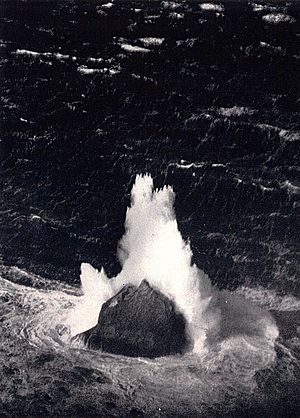
Many different squadrons were based at Aldergrove during the war. They flew planes like the Hudson, Blenheim, and Hurricane. These aircraft helped protect the seas and skies.
After the Wars (1945-2009)
After World War II, Aldergrove continued to be an important RAF base. In the 1950s, it was chosen as a place where the RAF's V bomber planes could land if needed. These were large, long-range bombers.
Aldergrove also became a major place for maintaining and fixing aircraft. For example, No. 23 Maintenance Unit RAF worked on McDonnell Douglas F-4 Phantom II jets here. The base was also the main service station for the English Electric Canberra aircraft. By 1976, around 2,500 RAF staff and 1,500 civilians worked at Aldergrove.
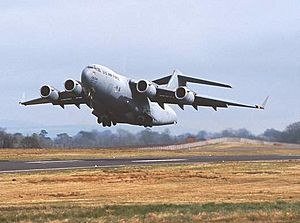
From 1981, No. 72 Squadron RAF operated Westland Wessex helicopters from Aldergrove. Later, in 1992, No. 230 Squadron RAF moved here with their Westland Puma HC.1 helicopters. These helicopters were used to support the British Army in Northern Ireland. No. 18 Squadron RAF also had detachments of Boeing Chinook helicopters here.
The Army Air Corps also used Aldergrove. They flew helicopters like the Westland Lynx and Westland Gazelle. They also used small planes like the de Havilland Canada DHC-2 Beaver and later the Britten-Norman Islander. These aircraft helped with reconnaissance and intelligence gathering.
Becoming a Joint Base
During the later years of Operation Banner, which was the British Army's operation in Northern Ireland, the units at Aldergrove came under the Joint Helicopter Command (JHC). This meant that both Army and RAF helicopter units worked together. Because of this, the base was renamed Joint Helicopter Command Flying Station Aldergrove.
On 20 September 2009, Aldergrove officially stopped being an RAF Station. The RAF flag was lowered, and the Joint Helicopter Command flag was raised. This marked the change from an RAF base to a joint military flying station.
What Happens There Now?
After Operation Banner ended, other Army units moved to Aldergrove. The base is now managed by 38 (Irish) Brigade.
5 Regiment Army Air Corps still operates from Aldergrove. They use Gazelle, Defender, and Islander aircraft. These planes help the Police Service of Northern Ireland (PSNI) and military units with their operations.
Aldergrove is also used as a training camp for young people. Cadets from the University Air Squadron and Air Training Corps from Scotland and Northern Ireland come here. They get to experience flying, learn fieldcraft skills, practice shooting, and get first aid training.
In 2003, Air Force One, the plane used by the U.S. President, landed at Aldergrove. This happened when the President visited Northern Ireland.
In June 2021, the Britten-Norman Islander and Defender aircraft of No. 651 Squadron AAC were retired from service.
Who is Based at Aldergrove?
Here are some of the units based at Aldergrove today:
British Army
Joint Helicopter Command / Army Air Corps
- 5 Regiment
- No. 665 Squadron – They fly Westland Gazelle AH1 helicopters.
Royal Logistics Corps
- 11 Explosive Ordnance Disposal and Search Regiment
- 321 Explosive Ordnance Disposal & Search Squadron – This unit deals with bombs and searches for dangerous items.
Civilian
- Police Service of Northern Ireland
- Air Support Unit – They use Eurocopter EC135 and Eurocopter EC145 helicopters to help police work from the air.
Royal Air Force
No. 1 Group (Air Combat)
- No. 1 Intelligence Surveillance and Reconnaissance (ISR) Wing
- No. 3 ISR Squadron (Regional Intelligence Geographic Centre-Northern Ireland) – This unit gathers and analyzes information.
- No. 502 (Ulster) Squadron (Royal Auxiliary Air Force) – This is a reserve RAF squadron.
No. 22 Group (Training) RAF
- No. 6 Flying Training School
- Northern Ireland Universities Air Squadron – Students learn to fly Grob Tutor T1 planes.
- No. 13 Air Experience Flight RAF – This unit gives flying experiences to cadets using Grob Tutor T1 planes.
See also
- List of former Royal Air Force stations
- RAF Nutts Corner


